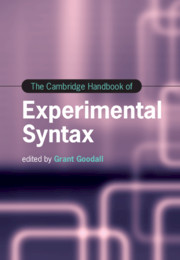Book contents
- The Cambridge Handbook of Experimental Syntax
- The Cambridge Handbook of Experimental Syntax
- Copyright page
- Contents
- Figures
- Tables
- Contributors
- Introduction
- Part I General Issues in Acceptability Experiments
- 1 Sentence Acceptability Experiments: What, How, and Why
- 2 Response Methods in Acceptability Experiments
- 3 Approaching Gradience in Acceptability with the Tools of Signal Detection Theory
- 4 Variation in Participants and Stimuli in Acceptability Experiments
- 5 Acceptability, Grammar, and Processing
- 6 Satiation
- 7 Acceptability (and Other) Experiments for Studying Comparative Syntax
- Part II Experimental Studies of Specific Phenomena
- Part III Experimental Studies of Specific Populations and Language Families
- Part IV Experimental Syntax beyond Acceptability
- Index
- References
5 - Acceptability, Grammar, and Processing
from Part I - General Issues in Acceptability Experiments
Published online by Cambridge University Press: 16 December 2021
- The Cambridge Handbook of Experimental Syntax
- The Cambridge Handbook of Experimental Syntax
- Copyright page
- Contents
- Figures
- Tables
- Contributors
- Introduction
- Part I General Issues in Acceptability Experiments
- 1 Sentence Acceptability Experiments: What, How, and Why
- 2 Response Methods in Acceptability Experiments
- 3 Approaching Gradience in Acceptability with the Tools of Signal Detection Theory
- 4 Variation in Participants and Stimuli in Acceptability Experiments
- 5 Acceptability, Grammar, and Processing
- 6 Satiation
- 7 Acceptability (and Other) Experiments for Studying Comparative Syntax
- Part II Experimental Studies of Specific Phenomena
- Part III Experimental Studies of Specific Populations and Language Families
- Part IV Experimental Syntax beyond Acceptability
- Index
- References
Summary
Acceptability and grammaticality are clearly closely related, but the relationship is not always straightforward. Sometimes, sentences that are thought to be ungrammatical are perceived as acceptable, leading to an illusion of grammaticality, or grammatical sentences are perceived as unacceptable, leading to an illusion of ungrammaticality. Such cases occur with morphological ambiguity, attachment ambiguity, agreement attraction, and negative polarity items, among others. Processing difficulty is one of the factors that can lower the acceptability of a grammatical sentence, as may be seen in the effects of constituent length and dependency length on acceptability. In some cases, such as superiority violations and island violations, it has been argued that these may actually be grammatical, but unacceptable, though this is the topic of much ongoing research involving cross-linguistic work and studies on repeated exposure (satiation) and memory capacity. Having better models of acceptability and better ways of directly measuring grammaticality would be desirable.
Keywords
- Type
- Chapter
- Information
- The Cambridge Handbook of Experimental Syntax , pp. 118 - 153Publisher: Cambridge University PressPrint publication year: 2021
References
- 4
- Cited by

